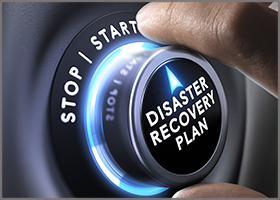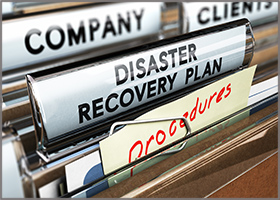
Out of sight. Out of mind. That’s a trap we all fall into. Usually, the consequences aren’t severe. When it comes to business, however, that mindset can come back to haunt you.
That’s certainly the case with disaster recovery. The only time disaster recovery seems to be top of mind is right after a disaster. The longer the time between events, the more disaster recovery plans sit on the back burner.
This is where companies get into trouble.
The Rise of Disaster
 Nowadays, threats that can lead to a disaster event are rampant. Malicious attacks on private data are becoming commonplace. According to USA Today, billions of people were affected by cyberattacks in 2018, with 765 million people affected between April and June alone! And while 30% of 2018’s cyberattacks caused less than $100,000 in company damages, Statista points out that 53% of the attacks caused financial damages of over $500,000.
Nowadays, threats that can lead to a disaster event are rampant. Malicious attacks on private data are becoming commonplace. According to USA Today, billions of people were affected by cyberattacks in 2018, with 765 million people affected between April and June alone! And while 30% of 2018’s cyberattacks caused less than $100,000 in company damages, Statista points out that 53% of the attacks caused financial damages of over $500,000.
That’s a big chunk of change for any company, and it can be absolutely crippling for small businesses. Without an updated disaster recovery plan that can be quickly deployed, the cost of an attack only goes up.
So, what can a company do? First of all, make sure to avoid these 5 key disaster recovery planning mistakes.
- Not Testing Frequently Enough
According to Inc.com, 60% of small businesses fold within 6 months of a cyberattack. Regular disaster recovery testing can lessen the risk by ensuring effective processes are in place and the right personnel are involved, know the plan and know how and when to execute processes.
To figure out a rate of testing, look at key factors that determine your threat level, such as the size of the organization, the amount of employee turnover, application requirements, and changes to infrastructure.
Disaster recovery planning includes staying ahead of the technological curve. Therefore, a company needs to schedule frequent intervals of implementing the newest updates against potential threats in addition to regularly testing recovery processes.
2: Choosing a Provider with Data Centers Too Close to the Primary Data Center
The problem is simple to understand. Let’s say there is a natural disaster that is causing operations to shut down. If a backup data center is too close to the primary data center, it may likely experience the same disaster.
For this reason, planning the distance of a backup data center is key. Make sure that the locations are on different power grids. If the company is in an area where floods are common, for example, the backup center should be a good distance away.
However, the backup center shouldn’t be too far. Keep in mind that staff may need to get to the backup center as quickly as possible. Think of it as the Goldilocks principle: the backup data center should be located not too far away, and not too close, but just the right distance.
- Failure to Distinguish Between Backup and Recovery and Disaster Recovery
Backup and recovery is vitally important, but it’s not the same as disaster recovery. Backup is typically performed on a daily basis, primarily for copying and storing vital data for easy recovery.
Disaster recovery comes in when vital applications, systems, or infrastructure are down, resulting in a potential loss of revenue or compute access. Companies should establish a recovery time objective (RTO) to set goals for how quickly their disaster recovery plan can get them back in business.
- Not Having a Formal Plan
Without a formal disaster recovery plan to follow, there is no order to restoring operations. In this situation, a molehill can quickly grow into one very expensive mountain.
A formal plan details all the steps needed for restoring operations. It will designate the roles of employees, list assigned tasks, and streamline the recovery process. So instead of mass panic, there are employees working smartly to quickly address the situation.
- Failure to Anticipate Possible Disaster Scenarios
How many huge storms have we already experienced this year? How many cyberattacks? What about power outages? Is there an escalation list in place in the event management or key personnel are unavailable? Does everyone on the team know how to contact each other with their various contact info including home phone, cell, alternate phone, etc.? Plan for the unexpected and anticipate what may happen in a company’s geographic area.
If a company has multiple locations, what happens if one, two, or three go down? As a wise man once said, “Prepare for the worst and hope for the best.”
 DRaaS for Loss Prevention
DRaaS for Loss Prevention
Downtime means a loss in revenue, productivity, and customer relations. FirstLight’s cloud-based Disaster Recovery as a Service (DRaaS) will give you the ultimate protection against every type of disaster.
Interested in learning more about our DRaaS solutions? We’re co-hosting a DR Lunch and Learn with our DRaaS partner Veeam in their Boston office on August 21. Sign up today. Give us a call today to learn how we can design, develop, and implement a rock-solid disaster recovery plan for your business.




















